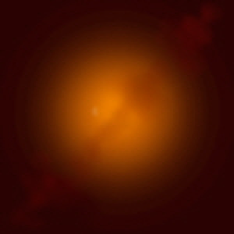So, we now have an embryonic star at the centre of a swirling cloud of gas and dust, and it is this cloud that is responsible for the majority of the light variations seen in many young stars.
The star starts to rotate due to the existing motion of the material around it, and so this material will tend to form an accretion disc around the star (other stars, such as dwarf novae and novae proper, have accretion discs as well, but the cause is completely different). This disc can eventually go on to form a planetary system which is why all the planets in the Solar System revolve in more or less the same plane; it's a relic of the time that our Sun was a Young Stellar Object.

The rotation of the star can perhaps set up a dynamo effect, causing areas of strong magnetism to break out. Again, we see this on our own Sun in the form of Sunspots, but in the case we are considering now, the spots are in all probability much larger. This can produce variations in light as the star rotates and the spots come, go, grow and shrink as seen from our viewpoint. Such variations are usually small, no greater than about 0.8 magnitudes, and may betray an underlying periodicity. These spots probably appear at a fairly late stage in the star-forming process since they are associated with objects in which we see no evidence of the accretion disc, the so-called Weak-Line T Tauri stars (WTTs).
T Tauri variables are characterised by being objects of about the Sun's mass, and observationally show variations up to about 1.5 magnitudes. Chemically they are recognised by the presence of Lithium, an element which is rapidly destroyed as the YSO begins shining as a star (i.e., when hydrogen burning begins in the star's core).
If there is an accretion disc present - the Classical T Tauri stars (CTTs) - there is potential for other variations to occur which are caused by interactions of various kinds between the disc and the star. In these cases the variations may be less regular and also less gentle - up to 3 magnitudes variation. This type of variation probably represents the largest number of stars in the 'YSO zoo' that have tended to be observed by amateur astronomers - though it is worth bearing in mind that these various classes of star are not always as cut-and-dried as they seem; one star may be subject to several influences at the same time, or go through various phases of behaviour during its early lifetime.

Because of turbulence in the swirling accretion disc and other factors in the star's environment, the material can begin to form regions of mass concentration which will generate a state of positive feedback, causing these regions to themselves accrete into clumps, from which planets may form. These clumps will be of various sizes and if conditions are right (i.e., if the clumps can obscure the star as seen from our viewpoint in space) then they will dim the light we receive from the star - exactly in the same way as in an eclipsing binary like Algol. In fact some stars that we now know are YSOs, such as BO Cephei, were formerly classed as Algol-type variables! These stars are called UX Orionis stars (UXORs) and are very interesting to observe.
Last but not least are those types of stars which exhibit light surges (superficially rather similar to a nova outburst) due to enhanced periods of being dumped on by the accretion disc. One of the first stars to be observed 'in the act' was FU Orionis, which has given its name to the FUOR subclass. FU Ori was originally thought to be what was called a 'slow nova' when it gradually rose from magnitude 16 up to 9 in 1937. However, unlike a nova, FU Ori did not fade back into obscurity; in fact it is even now more or less the same brightness as it was then!
Related to the handful of known FUORs are the EX Lupi stars or EXORs. These are similar, but have more frequent outbursts which are of a vaguely periodic nature. Charts for both FU Ori and EX Lup are available from the AAVSO main site. To find out more about the various type of YSO, try the YSO zoo pages.

